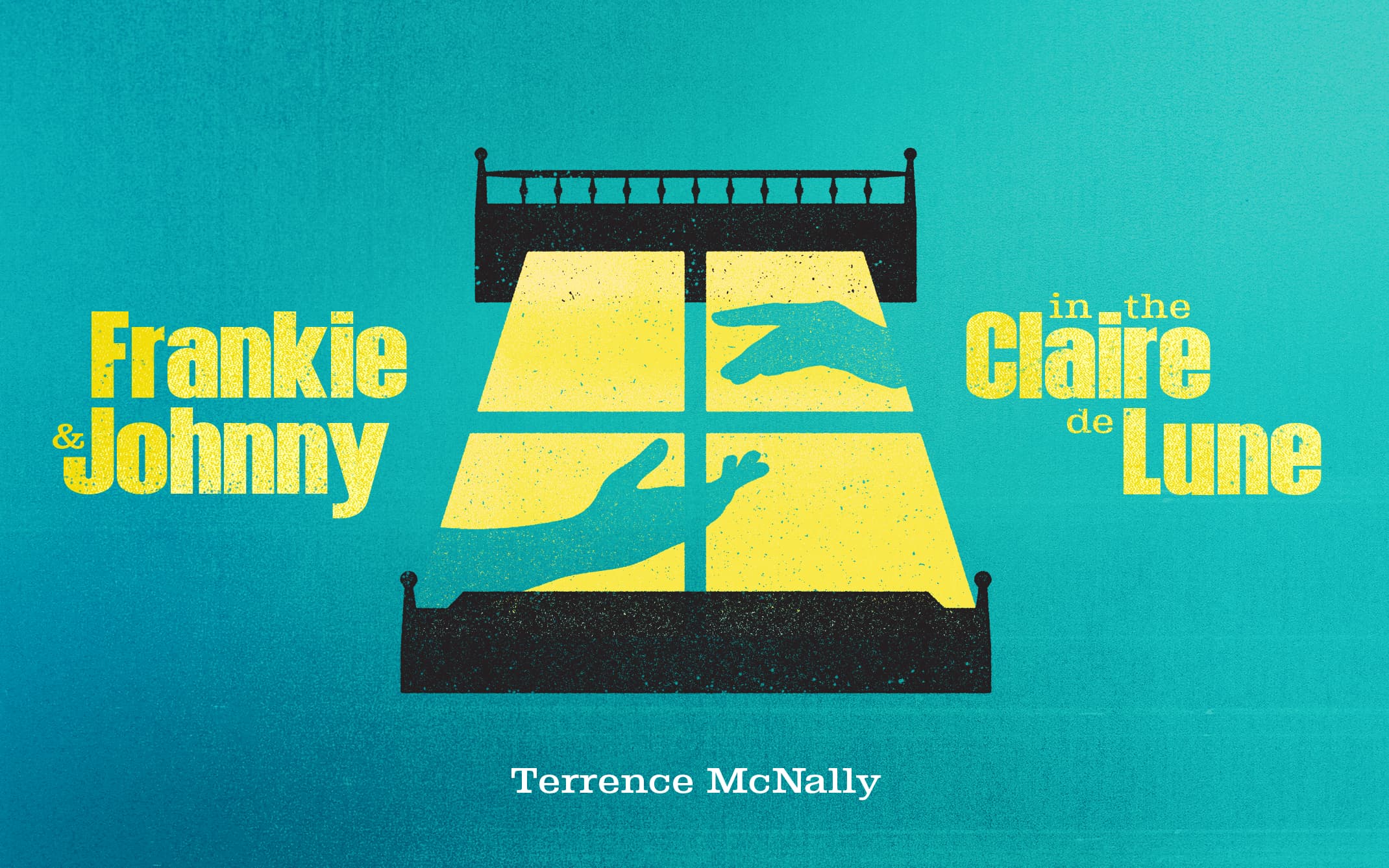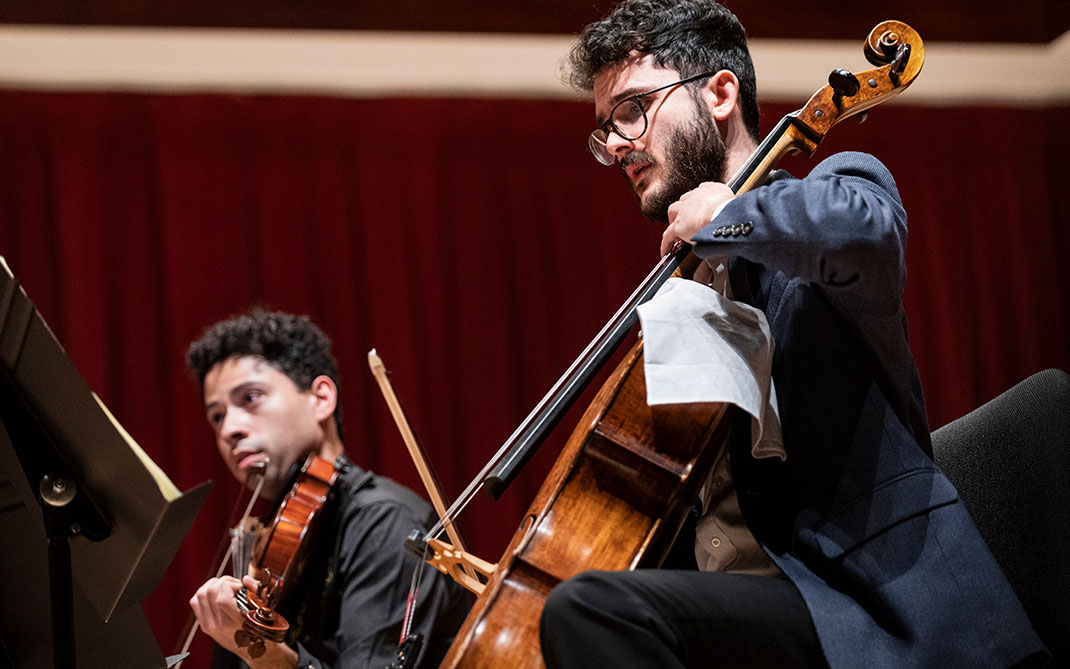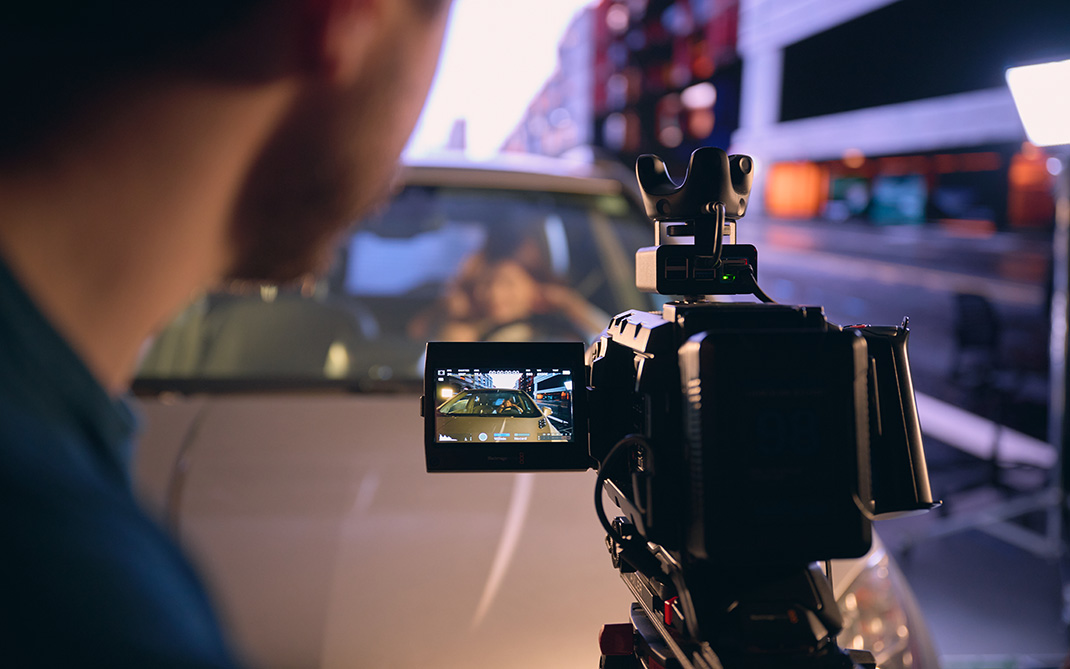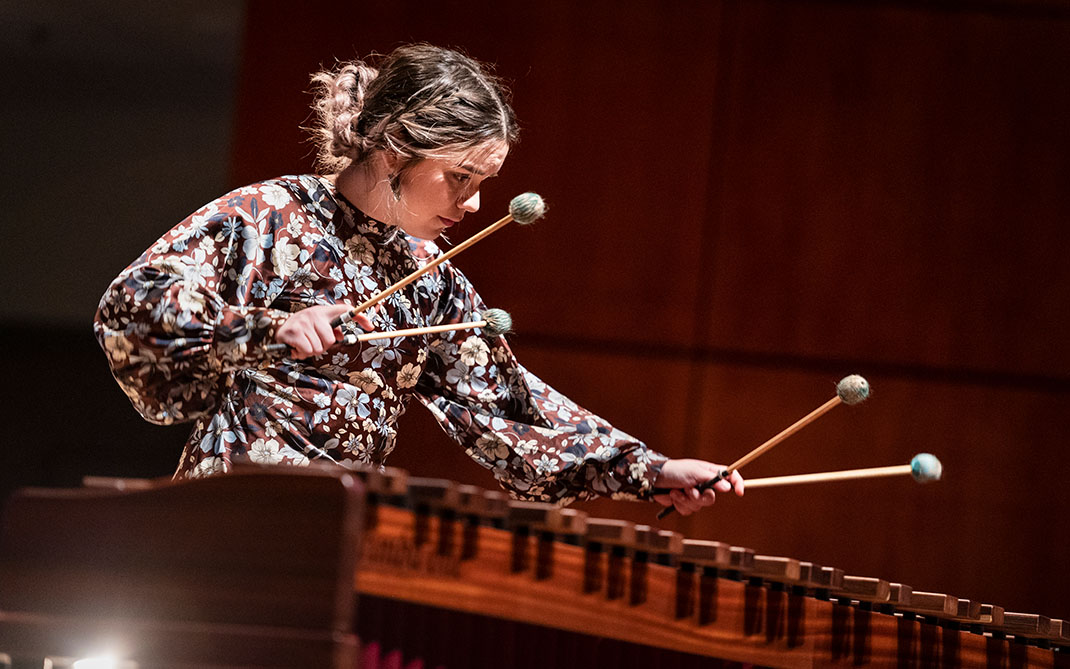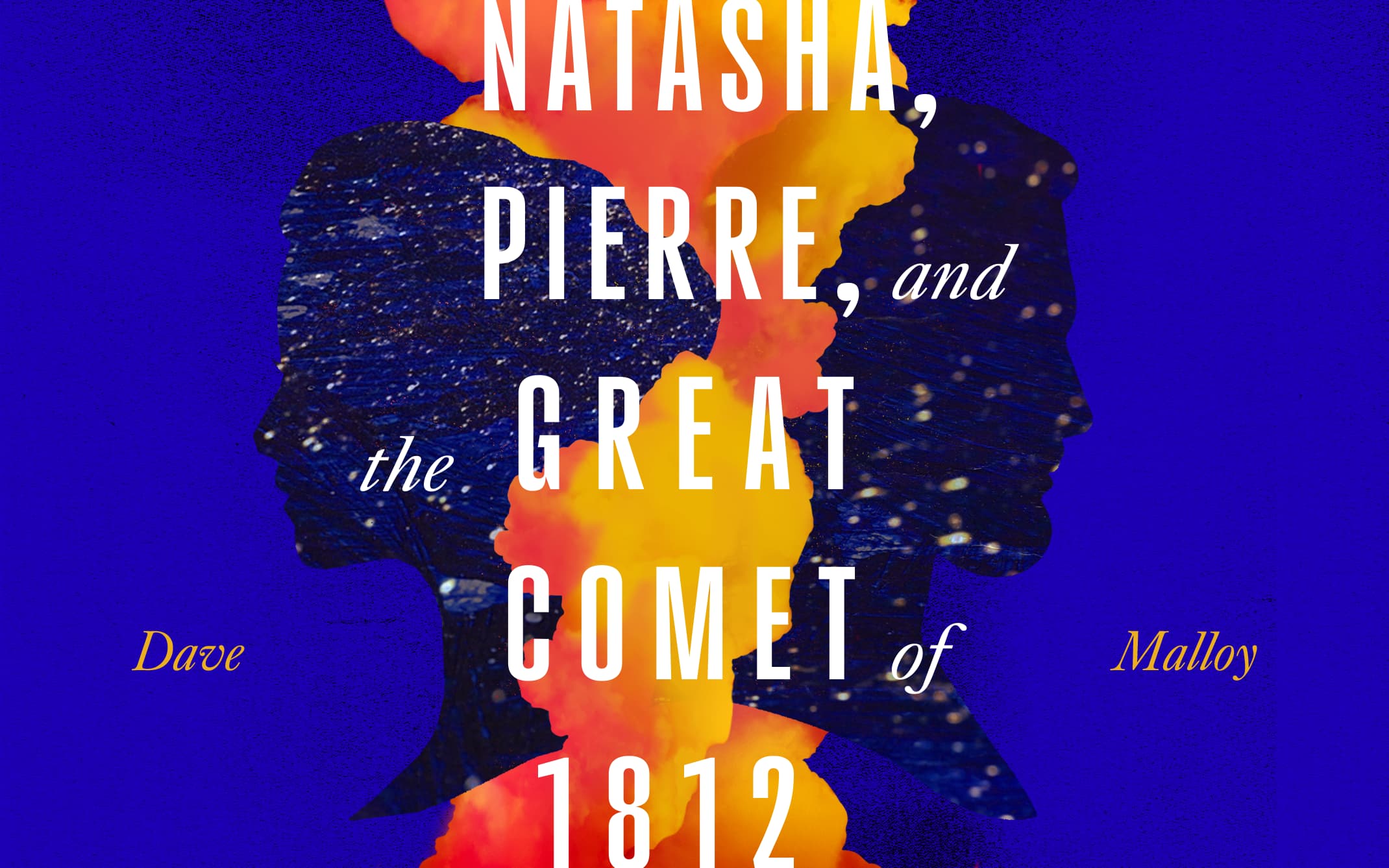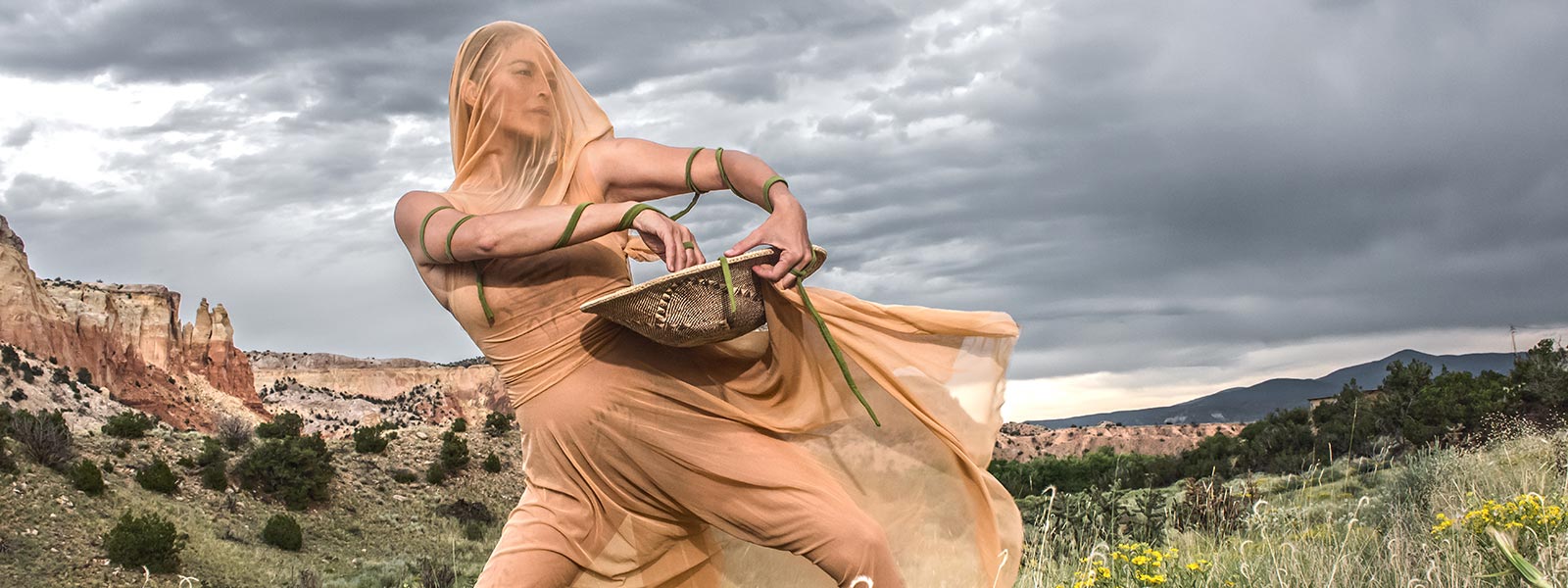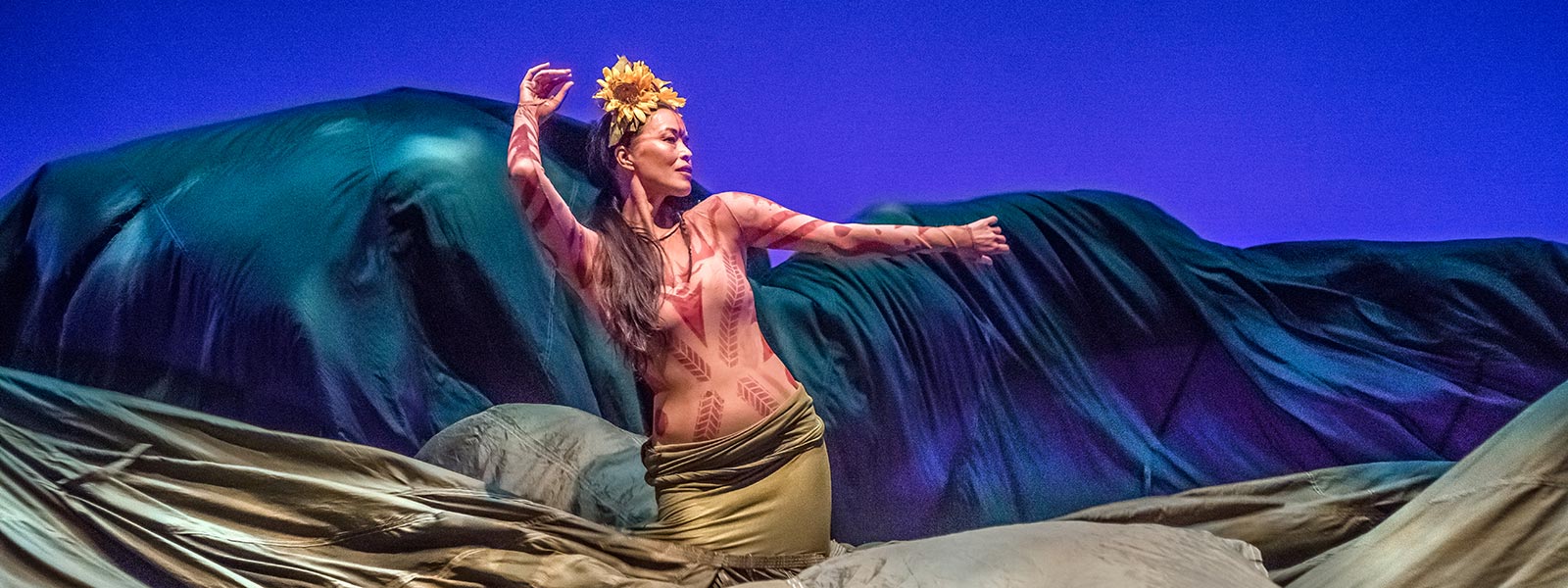Rulan Tangen
The views and opinions expressed by speakers and presenters in connection with Art Restart are their own, and not an endorsement by the Thomas S. Kenan Institute for the Arts and the UNC School of the Arts. This interview has been edited for length and clarity.
Dancer/choreographer Rulan Tangen was thriving in an international career as a performer and dancer when in 2004 she survived a bout with Stage 4 cancer. Emerging from the harrowing experience, she shifted her goals and committed herself to getting a brand-new company, Dancing Earth Creations, off the ground, and 17 years later she remains its founding artistic director.
Dancing Earth is a mixed-heritage company that creates contemporary dance deeply rooted and researched in the communities in which it works. Through its workshops and dances, Dancing Earth explores and links themes of ecological and social health and wellness, particularly in Indigenous communities. Dancing Earth has led workshops in many Native reservations, and to date the company has included artists from 28 First Nations as co-creators.
In this interview with Pier Carlo Talenti, Rulan describes how she and her company navigated the upheaval of the pandemic. Although their full year of touring was canceled in an instant, Rulan and her collaborators learned to become even more limber than they’d been before, finding evermore inventive ways to engage with their audiences and community partners.
Choose a question below to begin exploring the interview:
- I’m curious to hear specifically from you how you experienced the year 2020.
- What lessons from that experience are you planning to continue now that we’re returning at least in this country to a semblance of normalcy?
- Did you seek and accept help [during the pandemic] in a way you hadn’t before?
- What would you like to see fundamentally change in the world of dance?
- It sounds like you’ve had to learn some important lessons about how you want to lead also.
Pier Carlo Talenti: I’m curious to hear specifically from you how you experienced the year 2020.
Rulan Tangen: Thank you so much, Pier Carlo, for asking me this. Even though I think the sort of common mundane part of this story is that we all were completely out of work, I think the deeper question is the role of artists in society, especially when the whole thing implodes and collapses. I do feel like artists are the visionaries because artists are constantly being creative in challenging and changing circumstances. So who better than artists to not only comfort the community but also to provide spaces of imagination, either propelled by the artist or demonstrated by artists? I take that role to heart, and I’m going to actually bring this conversation to where I had to go.
Like everyone else, I was without human community and my art is ... I think all performers have to engage with people whether they like it or not, but certainly in the art that I’ve facilitated as the Artistic Director for Dancing Earth, a lot of it is community-sourced, so not only are the artists onstage but it could be farmers or elders, or culture carriers, or open conversations that are facilitated. And suddenly I was without human community. There’s a lot I can say about that, but what I can say is I didn’t really feel myself to be lonely. There was certainly a difference, a difference that I had to adapt and adjust to, but I had time on many days to take a walk outside, even though I was working many, many hours.
I took a walk outside, and I connected with the beyond-human-beings, who have always been my teachers, my teachers who are beyond human. There were different — I think you could call it teachings or sharings or learnings — that came from me listening during different seasons to the desert and the dried riverbed, which many look at and see, “Oh it’s all dead. It’s all brown. It’s all dried.” But there’s an incredible ecosystem that’s very diverse because to survive in the desert … a million living things find a million ways to survive in the desert.
Of those, I think there were probably eight different expressions that I’d love to share with you, not necessarily what I learned but where I learned them from. Some people might find it to be poetic or metaphor, but I actually found it to be very direct.
These eight different directions or mini-seasons that came to me: The first one would have been in March. The first part that I learned was from the wind. It was March, and we have big dusty winds which I always get kind of irritated by.
Pier Carlo: Where were you? Because you live both in the Bay Area and in New Mexico, right?
Rulan: Good question. Yes. I had just come back from the Bay, and I was in New Mexico at the time. I’d love to just acknowledge those as the Bay Area being stolen, occupied Ohlone territory of Yelamu, now known as San Francisco; and in New Mexico, occupied, stolen Tewa lands now known as Santa Fe, not quite in Santa Fe. I’m near but good enough for this conversation, I think.
There are plants that have been given the name weeds, but they really can move into life quickly, and they’re very resilient. They don’t need much to survive on. And gosh, I think artists can be weed sometimes.
I learned from the wind. I get irritated by the wind, and then of course farmers tell me, “Oh well, that’s how pollination happens.” As that came through, I felt this pollination. There are plants that have been given the name weeds, but they really can move into life quickly, and they’re very resilient. They don’t need much to survive on. And gosh, I think artists can be weed sometimes. [She laughs.]
I certainly became one. We had just done a premiere of a new production, and we were lined up for touring, maybe the first year where we’d had that much work in about a decade of building relationships. Some of the dancers had put three years of their life into creating this work. The common business knowledge that I was actually given in little business meetings — not within my company but out in the field — were that if you don’t tour, you don’t have expenses and so you just let the dancers go; they’ll figure things out. I found that to be quite inhumane. I didn’t think it was fair.
What I do when I feel things are not fair, I move into double-, triple-timing. You can imagine your feet in a very fast staccato rhythm. That became me, and like a weed moving into flowering or the wind pushing pollination, I decided to invent a whole new business, which doesn’t sound so new now but I didn’t know anything about doing classes online. In fact, the research at the time didn’t even indicate that Zoom was necessarily what it would be. So March 6th is when we’re starting to try to figure things out. Then to have a full programming online of online dance classes, panels for indigenous LGBTQ+ associates, another panel for Afro Indigenous artists and culture carriers, lectures by native elders who have been the founders of the native contemporary dance movement, really, in an effort to just not only give a little funding to keep people going but even more so to keep their creative lives going, to keep them fulfilling their purpose on this planet and to serve our communities.
Pier Carlo: What lessons from that experience are you planning to continue now that we’re returning at least in this country to a semblance of normalcy?
Rulan: Well, what was considered normal wasn’t balanced or equitable. What is normal for people, to be able to get a performance, isn’t normal for people who are immune-compromised or are in wheelchairs. What’s normal in the arts field, particularly for people of color, was never right beforehand.
I’m actually seeing that those small companies of hardy, resilient folks who managed with or without funding for years, their strategies are what other people are turning to.
I’m actually seeing that those small companies of hardy, resilient folks who managed with or without funding for years, their strategies are what other people are turning to. The people who had no admin staff to fire or the people who have been honing strategies for survival and resilience for generations have a lot to draw on right now. We’re seeing how people who come from marginalized, under-resourced backgrounds are standing up, becoming the leaders of the new movement across the board — arts and otherwise.
Pier Carlo: Since we’re using the term weeds, the scrappy weeds are the ones that survive.
Rulan: Yes. Which brings me to my second teaching, which is about the dandelion. So here we were, we’re planting all the seeds. Then at a certain point — let’s call it the fall — things started to shift where all that had been really given to artists over perhaps years but certainly in the last few months, where they started to take on their own sovereignty, doing things on their own. They’ve now gained skills and confidence, perhaps with video performance or maybe they already had those skills, they had different opportunities coming from Dancing Earth. A lot of folks have been taking on their own projects and doing that for their own communities, where they are.
I think of that as something really healthy, when you see people that you mentor or support, even for a moment, when they become even better leaders than they were before. I’m definitely seeing that now. I’m not so much on social media, but when I am, I’m like, “Oh, look, look what this person is doing now!” Where they’re becoming not only leaders making creativity for themselves but also for others. That’s something I’m so happy about.
When all that happens, then I move to the third teacher, which is a rock. When you look at those rocks, you realize that your sense of time and your sense of action is very ... like you just have a little slice of it. I look at the smooth river rock, I’m like, “Hm, it got smooth from water over a long period of time, and even what I’m holding in my hand is not inanimate. There’s tons of activity that I can’t even see.” So for Dancing Earth, I think that took the form of appearing inactive for a period of time where there was a lot going on that was invisible to the eye, whether that was recalibrating what we want to be in the world or looking at our systems, because we had been doing a lot just flying by the seat of our pants, “make it happen.” People have always said, “You know, if we just had a little bit more time to plan things out.” So I say, “OK, I hear that I’ve been driving everyone to beyond capacity because we constantly have a lot of community members to serve, and perhaps this is the time to slow down from that and really get better situated and ground ourselves like rocks.”
Next to a rock you’ll often see a branch, and that’s my next teacher, the fourth teacher. When a branch falls from a tree, the water has dried out and it takes this ... like my arms right now, they’re making this twisted shape, and if I was to pantomime “branch” to you or “here’s the dance of branch,” you’d see this twisted shape. I realized that that twisted shape is actually the shape of water. Roots look like that, branches look like that; it’s the movement inside of them. Even when they dry down, it’s still that water shape. So even though we weren’t actively producing programs, we were learning from all the work that we’ve done for 17 years. “OK, what worked, what didn’t work?” Using those as templates.
Also in the dried riverbed that is now my big teacher you’d see the footprints left behind of humans, of animals. The footprints that we’d left from all the work that we had been doing meant that there were a lot of groups that were reaching out to request programming. So even though we weren’t actively producing our own, there were many groups that still wanted someone to come and teach online twice a week. So we’re still doing that.
People would be like, “Gosh, your version of being quiet is other people’s version of being busy!” But I think I find it very difficult to say no when people are reaching out for dance or movement because I feel like that’s really what can make us fully human that many folks have not been able to have access to. People are like, “Oh, I don’t like dance, I don’t know what dance is, I’m not a dancer.” But it gets down to being in your body, being fully human. Can you be in your body and move? From that comes dance. But for me it’s about first just being fully human in our bodies.
Pier Carlo: And the sixth lesson?
Rulan: When something in the arroyo falls — let’s say I’m eating something and a crumb falls down — ants come together, and they work to harvest that. And I thought of times when I felt like I had fallen down and so many folks came out towards me and they were like, “Keep this going!” I honestly was like, “Is dance still needed? Am I still needed?” All of these existential questions that probably every arts leader finds themselves asking. So many folks came forward: “Lift up, prop it back up, here’s what you should be doing.” A lot of people coming forward to say, “How can I help?”
Pier Carlo: Did you seek and accept help in a way you hadn’t before?
Rulan: I did. I will say that there’s a caveat and it’s that maybe the other time where I learned this accepting help, seeking help as being part of a reciprocal circle, was right before Dancing Earth was founded, which was with my battle with cancer. I had said to myself over and over [laughing], “I don’t want to have to learn that hard way again.” At that time, I had to ask for help. I had to receive help and really felt that reciprocity. That did come forward again in the winter of this year up until now, really starting to shift to reflect that community that’s really actually global that’s coming forward to say, “Dance is still important, Dancing Earth is still important, you are still important.” And that’s why I’m still on this call, I guess, speaking with you.
Pier Carlo: It’s so interesting — if we’re bringing it back to the ants, the community or the hive working together — that both of those moments occurred during moments of health crises, one which was very personal for you and the other one being a pandemic.
Rulan: Yes, for sure. I mean certainly any person or community or culture who’s gone through extreme struggles ... . I don’t know, I feel like it can also diminish the pain and suffering if you’re like, “Oh well, from the struggle you learn, and then things get better.” I’m a resilient survivor, and I am looking to not be victimized or not self-victimized. I want to learn and grow, which involves the pain of change but also trying, failing, trying again.
I think that kind of gets me to my seventh teacher. In the arroyo you also see bones and antlers. I looked at them, and I was like, “You know, this was something live that was thundering down this arroyo, probably with much more life force than I have right now, and they’re still here. They’re dried down to their essence. Those bones last a real, real long time.” What I did with some of those bones, I remade them into art pieces — or they were remade into art pieces by a friend — which I was dancing into life a few days ago. I think there’s a metaphor in there about continuance. I’m not sure what I have to say, like continued transformations and collaborations that are continually evolving, looking at what seems to be done, over, dead, dried up, it can also be beautiful and something of essence. Certainly the dance piece that I was called to make with the bones did feel like that to me.
Pier Carlo: So your message is metaphorical, but these are actual physical bones that were in your dance piece?
Rulan: Yup. [She laughs.] They were my collaborators. Instead of dancers, I had bones and rocks and dried flower. Everything I chose on stage was with the incredible multi-artist named Marion Claire Wasserman. She had taken these pieces from the desert, these dried yucca pods, these dried horsetail. There was a shell. On parts of them she did a light coating of gold, and I actually am thinking about ... . There’s a beautiful Japanese art form that I’ve seen and admired which is something broken that gets put back together, essentially glued back together, with gold. I think what she found with the bones, they were beautiful as is, but this application of gold reminded me of the performance process. It might be something that’s everyday reality, but there’s a heightened attention, there’s a heightened sensibility, there’s a heightened refinement of intention that you could equate to a lining of gold that catches the light.
Pier Carlo: Let me ask you a very broad question, which is what would you like to see fundamentally change in the world of dance?
Rulan: I think one thing that has been very different about Dancing Earth is that we ... . Well, for a long time there wasn’t an admin; until the last few years there really wasn’t that much admin support. There’d be people coming in part-time, a single person at a time here and there, but we didn’t have a team or a system because I was centering the artists and the art-making. How that plays out now, even though there is some part-time staffing, is that I’ve really put my feet on the ground and said, “We all get paid the same rate, whether that’s the director, the grant writer, the dancer.”
Because oftentimes what was presented to me as a really effective business model … if I looked at it, it was a pyramid structure where the people on the bottom were getting paid the least and the people in the bottom were also the frontline workers, one might say, the dancers, the performers, and teachers, who were also definitely the people of color, although our entire organization is BIPOC.
I’ve been told so many times that we would have a more stable company if there was a managing director who is paid much more ... and I haven’t been able to shift to that. That didn’t seem right to me.
I think that that’s a certain type of equity and justice that I haven’t been able to see a way around. I’ve been told so many times that we would have a more stable company if there was a managing director who is paid much more or I hired a development director at 10 times more, and I haven’t been able to shift to that. That didn’t seem right to me.
Pier Carlo: When did you make this commitment to pay equity?
Rulan: Oh, from the beginning. Yeah, from the beginning. Unfortunately — and this might lead me to maybe the eighth lesson — except for me because as a founder you put in tons of unpaid time, which when you balance that out, it becomes inequity. So the only one who was receiving inequity was me, and I’m looking at that because that could also lead to other patterns that aren’t healthy. That said [laughing], I’m already putting in my 10th hour today because I do have a lot of energy. I have a lot of energy that comes from creativity, that creativity requires.
Pier Carlo: It sounds like you’ve had to learn some important lessons about how you want to lead also.
Rulan: That’s still emergent, yeah. Coming out of this whole period, I had this sort of frantic making and then the pausing. But I’d say that pause, like you said, because it’s so rare, I would call it like the underground time, the time of going into the darkness. And that was happening on many different fronts, going into the darkness personally, professionally, financially, every different way. Someone reminded me that a cocoon is actually decay; it’s decomposition. It’s not pretty. It’s not like nice little worm squirming around and then beautiful butterfly.
Pier Carlo: Right, it dissolves. It becomes this weird goop, and then it becomes a butterfly, right?
Rulan: Yeah, so I was feeling a lot of that weird goop for a lot of the early part of this year and not really being able to stand strong in my vision or creativity because we were in emergence.
I also am very clear that no matter what we envision or discuss or plan with a little strategic plan and a little organizational mapping, because the priority for me is the art-making and the artists … . We can talk about whatever we want, but until we’re in the room together, evolving what we’re going to be together, evolving what are our stories and what is the story that we want to tell together, to me, that’s all, I don’t know, it’s a wonderful exercise, right? That might support the process together. I’m saying that as we’re just at the verge of returning to some of our programs.
Now I know that these programs are going to be different. I don’t want to put a name to what that is because like I said I want it to evolve from our time together. I know in my gut. You know when you can feel it in your body? We say as humans, “I feel it in my gut.” I feel it in my body that there is a change coming or there is a change afoot, that all of this decomposition time is leading to something different, and I don’t want to name it yet because I want to let it become what it wants to become.
I feel that’s part of being an older artist, to be able to take relationships and opportunities to create, like I said, that dandelion ... to make creative pathways, pave pathways for others.
In that reflection time I think you’ll be hearing from a lot of artists, especially people who are leaders, that we’ve been putting the vision, the company, the group, the people — I’ll say, I have; I’ve been always putting them in front. If someone comes to me with an opportunity, I’ve always been like, “Oh, can I try to bring others in?” So there’s a service that’s there. There’s a constant cultivation of the light that shines on me; how can I get it to bounce on to others? I feel that’s part of being an older artist, to be able to take relationships and opportunities to create, like I said, that dandelion, to make — I keep using the word opportunity; I’m kind of getting tired of that word — but to make creative pathways, pave pathways for others.
September 07, 2021
